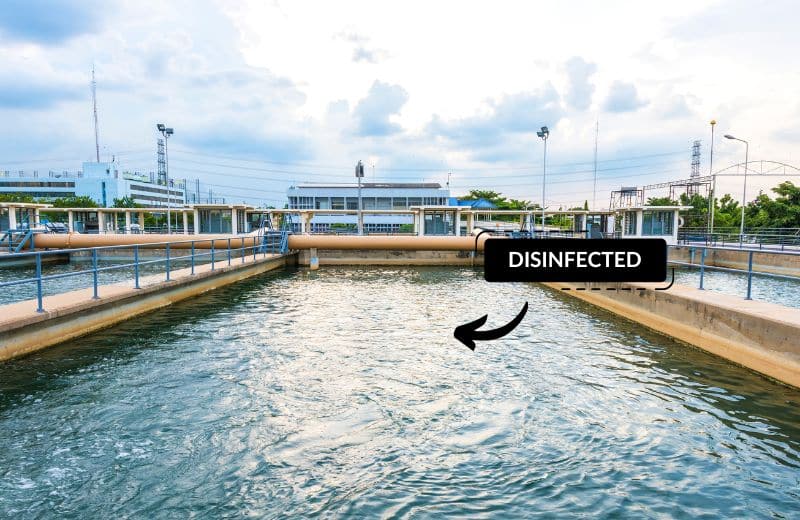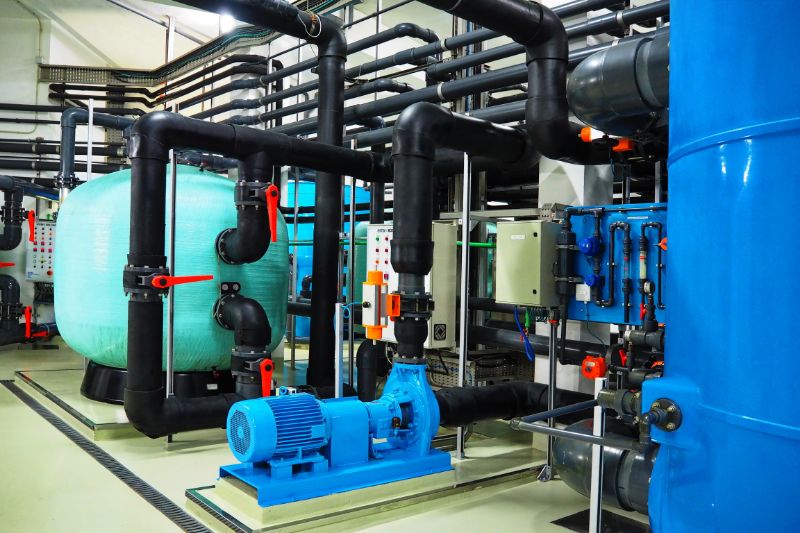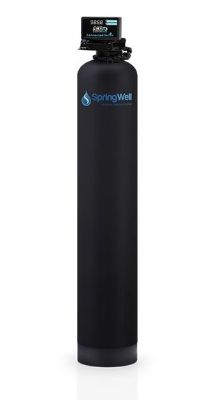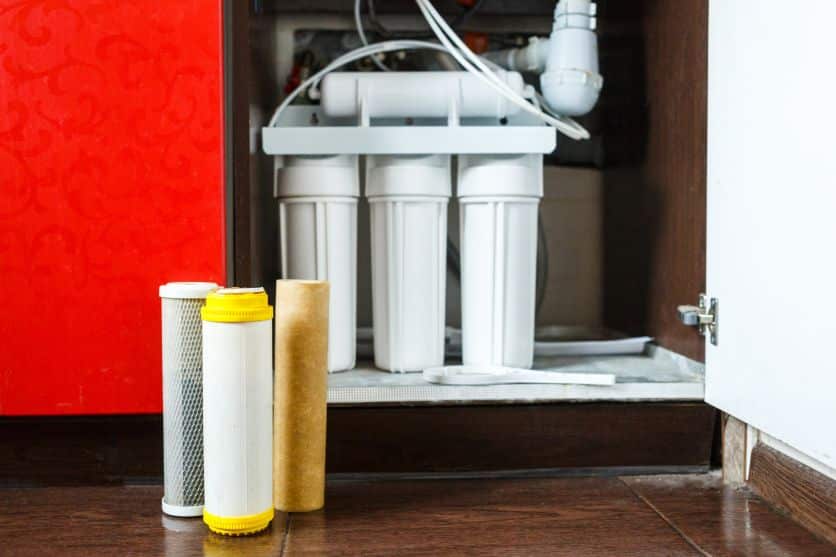Many tap water supplies in the US have been treated with chlorine or chloramines. While chlorine is still the most common disinfectant chemical, many municipalities now exclusively use chloramines for disinfecting their local water supply.
In this guide, I’ll be looking at what chloramine is, why it’s added to our water, and how to remove chloramine from tap water using several effective techniques.
Table of Contents
🤔 What is Chloramine and Why is it Added to Drinking Water?
Chloramine is produced from a chemical reaction between chlorine and ammonia. When chloramine is used to disinfect water, it’s known as secondary disinfection.
Although chloramine was introduced in the 1930s, it continues to increase in popularity, with the EPA estimating that around 1 in 5 Americans drink chloramine-treated water today.
Just like chlorine, chloramine is a disinfectant, used to improve the quality of our drinking water and remove the bad stuff that could harm our health.
There are several different types of chloramines (which is why you’ll often hear chloramine referred to in plural): dichloramine, monochloramine, trichloramine, and organic chloramines. Any of these can be used to disinfect water, though monochloramine is usually the most common and preferred option.

So, why is drinking water disinfected with chloramine or chlorine? Public water needs to be treated to kill a number of pathogens that could make us sick or seriously ill. Before widespread disinfection of public water existed, many people experienced illness, and some even died because their tap water was contaminated.
While disinfection with chlorine or chloramine adds a small amount of chemicals to water, the EPA ruled that the benefits of using a chemical disinfectant outweighs their potential risks.
Chlorination with chloramine is used to kill bacteria, viruses, and protozoa, which could cause the likes of cholera, hepatitis and typhoid in people who drink water contaminated with these pathogens. Chloramine and chlorine chemicals can break the structure of microorganisms and prevent them from being able to duplicate or cause illness.
Wondering why a safer, chemical-free means of disinfection isn’t used? Simply because filters and other contaminant reduction water systems don’t work when it comes to pathogens.
Bacteria, viruses and protozoa are too small for most filters, and the filters that can handle these tiny contaminants would need to be backwashed frequently to remain effective – which is hardly practical when treating water on a large scale.
What’s the Difference Between Chlorine and Chloramine?
Chlorine is a chemical on its own, while chloramine is chlorine and ammonia combined. When chlorine and ammonia are used together, the chloramine that’s produced is more stable, and is able to remain in the water for longer when exposed to air.
This is a good thing from the perspective of disinfection – it means that chloramines won’t leave your water before it reaches your home. When chlorine and ammonia aren’t mixed, chlorine dissipates at a faster rate.
If you don’t know whether your water is treated with chloramine or chlorine, that’s the first thing to find out. Get in touch with your local authority and request a water quality report.
This report should document how much chlorine and chloramine are used to treat your water, and whether one is used exclusively instead of the other. Many treatment companies are choosing to use chloramine to disinfect tap water nowadays, as it’s considered more efficacious than chlorine.
There’s also a big difference between chlorine and chloramine when it comes to extracting them from water. To remove chlorine, you can simply let tap water sit out for a few days, and it will eventually vaporize into the air.
Chloramines, on the other hand, are a more complex combination of ammonia and free chlorine, which means they aren’t capable of doing this. If your water contains chloramines, you will need to look at specific means of extracting this chemical in particular.
Related: 2024 Guide for Removing Chlorine from Water at Home
🩺 Health Effects of Chloramine
Both drinking and washing in chloramine can cause a number of unpleasant health effects, even if your water only contains trace amounts of chloramines that are considered safe by the EPA.
A few of the health effects of elevated levels of chloramine are:
- Respiratory problems and increased asthma risk from breathing in vapor containing chloramines
- Produces denaturation of hemoglobin in the bloodstream.
- Higher exposure can cause a build up of fluid in the lungs, a medical emergency, with severe shortness of breath
- Dry, itchy, flaking skin
- Dandruff and itchy scalp
- Dry mouth, lips and throat
- Aggravated digestive disorders
If your water contains low levels of chloramines, you probably won’t experience the serious side-effects of chloramine inhalation and consumption. But a common problem that many people notice is itchy skin, especially on the face, from direct contact with shower water containing chloramines.
If you have a skin condition like eczema, exposure from taking a shower in water containing chloramines may cause a reaction. The skin on your scalp may also be itchy and flaky as a result of chloramine exposure.
If you have respiratory problems of any sort, you need to be particularly careful when taking a shower in water that contains chloramines.
Chloramine produces a vapor when it reacts with the air, which may be harmful to breathe in. However, studies suggest that chloramine is more stable and far slower to evaporate than chlorine.
A health effect that many people don’t directly link to chloramines is their ability to alter the chemical properties of water, which can increase the amount of lead and copper in drinking water.
This may be an issue if water travels to your home via lead or copper pipes, as you may be ingesting large amounts of these metals, which have been found to have a whole host of adverse effects.
🚰 Is it Safe to Drink Chloramines in Tap Water?
According to the CDC, it’s safe to drink water that contains up to 4 milligrams per liter (mg/L) or 4 parts per million (ppm) of chloramines.
Municipal water treatment companies must legally comply with these standards and ensure that your drinking water contains this amount of chloramine or less.
It’s technically considered safe to consume less than 4 PPM of chloramines in your tap water, but, for the health concerns highlighted above, you may want to avoid coming into contact with any chloramine content at all, no matter how small.

✅ How to Remove Chloramine from Water
It’s easy to remove chlorine from water, but chloramine tends to be more difficult, because it takes more effort to get it to break down and leave water.
Not all treatment solutions can remove both chlorine and chloramine; in fact, some are only capable of removing one or the other.
If you want to be certain that your water treatment solution of choice will get rid of chloramine specifically, check out the options below:
Catalytic Carbon Filter
Catalytic carbon filtration is one of the most common methods of filtering chloramines from a drinking water supply.
There are many different filtration options when it comes to this type of filter – you may find a catalytic carbon pitcher filter, a whole home catalytic carbon filter, and even filtering bottles that contain this type of filter.
In a catalytic carbon filtering cartridge, the surface area is as large as possible, helping to increase activity and ensure the filter media can work as effectively as possible to adsorb chloramines and greatly reduce them from water.
When drinking water containing chloramines passes through a catalytic carbon filter, the chloramines are attracted to the media and stick to its surface. Water particles are not attracted to the filter media, and pass through to the other side.
You can only use a catalytic carbon filtering cartridge for so long before its pores will become too blocked for it to work effectively, which may result in poor flow and decreased efficiency. That’s why it’s important to change your filter as advertised by the manufacturer, whether that’s once every 6 weeks or once every 6 months.
The price of a catalytic carbon system depends on the form you buy it in. If it’s a part of a water filter pitcher, it may cost $20 to $50, while whole-house filtration options tend to be priced in the hundreds to thousands.
Installing this type of filter again depends on the form you buy it in. A filter pitcher takes seconds to set up and requires no invasive installation – you just click the filter in place and get started. If you’re interested in a whole-house solution, you’ll need to install the system at your main water line, while a faucet filter will connect straight onto your kitchen faucet.
Typically, this type of water filter may also remove lead and some heavy metals, but it’s largely used for improving tap water taste and odor.

Reverse Osmosis
A reverse osmosis filtration system can remove up to 99% of all total dissolved solids (TDS) from water.
It’s considered one of the most effective treatment solutions, and its design makes it particularly effective at removing chloramines. Many RO units consist of two catalytic carbon filter cartridges, which means that if any chloramine was able to make it through the first filter, it would be trapped by the second one.
Another bonus of RO systems is that, unlike any other type of filter, they feature a semi-permeable reverse osmosis membrane. Water is forced against this membrane at a high pressure, but with the membrane’s pores being tiny – usually about 0.0005 microns – only water particles are able to pass through.
The remaining contaminants, including any chloramine that managed to make it this far, are washed down a drain with wastewater.
It’s easy to see, from looking at this process, why reverse osmosis is so thorough, not only for chloramine removal, but for eliminating a broad range of other common contaminants in drinking water.
With an RO system, high levels of bacteria, VOCs (volatile organic compounds), lead and other heavy metals, pesticides and herbicides, fluoride, and other common contaminants that can result in poor-quality water are removed. Whether you get city water from municipalities or you use a private well source, removing chloramine from water with RO is highly effective.
A reverse osmosis filtration system may cost anything from $150 to $400, with some costing even more than this. You can buy systems for your whole house, as well as systems that are designed to be installed underneath your kitchen sink or on your kitchen countertop.
You’ll also need to factor in the cost of half-yearly, annual and biennial filter and RO membrane changes, which will usually set you back around $50-$75 a year.

If you’re handy, you should be able to install an RO water system yourself – no major plumbing knowledge needed.
If you just want to remove chloramines from your drinking water, look at installing the system beneath your kitchen sink. These under-sink systems usually come with an included faucet that will provide you with clean water. When you switch on the faucet, water will travel through the RO unit’s filter cartridges and membrane before passing out of the faucet.
Installing an RO unit at your home’s main water line will leave your pipes, plumbing, appliances, showers, heaters and faucets free of any contact with chloramine. This means you can shower in, as well as drink, chloramine-free water. Again, installation is relatively easy providing you follow the instructions carefully.
❔ Frequently Asked Questions
Why Can’t Activated Carbon Remove Chloramines?
Activated carbon filtration is considered one of the best methods of removing chlorine from water, but you can’t actually use this technique for filtering chloramine. That’s because, by design, activated carbon filters are intended for free chlorine removal, which means they have the wrong surface area or flow rate to adsorb chloramines. Typically, activated carbon filters have a surface area that’s too large or a flow rate that’s too high to effectively remove chloramines. For that reason, it’s advised that you use catalytic carbon filters, which give water a longer contact time with the media . This is needed to break the chlorine and ammonia apart.
Does Boiling Water Remove Chloramine?
Technically, yes: you could remove chloramines from water simply by boiling it. But the problem with boiling is that it won’t entirely remove chloramines as a filter could. When you boil water, it releases some of the dissolved chloramine gas as the temperature increases. But it’s nowhere near as easy to remove chloramines by boiling as it is to remove chlorine. You’ll need to boil for hours on end to even remove a small amount of chloramine, which is why it’s easier and more effective to use a filter for the job instead.
Are there any alternatives to chlorine and chloramine?
Yes – UV purification is capable of eliminating bacteria, viruses and other nasties in tap water just as chlorine and chloramine can. But this water treatment method isn’t used on a large scale as it’s too costly. If your water supply comes from the city, there’s nothing you can do about chlorine and chloramine in your water aside from removing them. If you have your own well, you can choose to treat your water with UV purification rather than using chemicals.
What is the NSF 42 certification?
If you’ve noticed that a filter cartridge or full system boasts an NSF 42 certification, you’re probably wondering about the significance of this. When a system is certified for NSF 42, it means it has been third-party tested by an accredited body and deemed certified to reduce aesthetic impurities such as chlorine and taste/odor.
Note that some systems can reduce or remove both chlorine and chloramine, while some can only remove one or the other. Check to see exactly what a system is certified for – it may only be certified for filtering chlorine, and if your city water contains added chloramines, that’s no use to you.
How do I benefit from getting chloramines removed from my water?
When you drink chloramine-free tap water, you won’t have to come in contact with chlorine or ammonia, which are unavoidable in most city water supplies. Both chlorine and ammonia can be damaging even when consumed in small amounts, and avoiding drinking these is the best thing you can do for your health.
Additionally, when water contains added chloramines, it has a chemical taste that many people don’t like. Studies show that in 2019 alone Americans drank nearly 15 billion gallons of bottled water – and most people resort to bottled water because they dislike the taste of their tap water. If you’re a bottled water fan, you probably like the sound of a cheaper, more environmentally-friendly alternative that’ll improve the taste of your own home’s water – and that’s what a chloramine filter can do.
